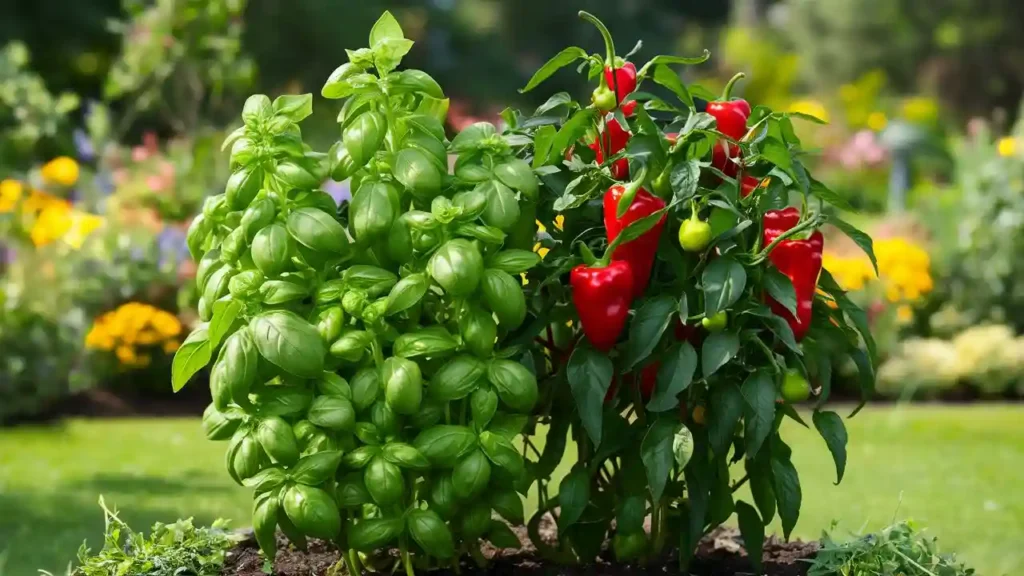Can I Plant Basil With Peppers?
Yes, basil and peppers are compatible companion plants. Basil can help to repel insects that can damage peppers, and it can also improve the flavor of the peppers. When planting basil with peppers, space the plants about 12 inches apart. You can also plant basil in containers with peppers.
Companion Planting Basil and Peppers
Basil and peppers are two popular garden vegetables that can benefit from companion planting. Companion planting is the practice of planting two or more different species of plants together to create a mutually beneficial relationship. In the case of basil and peppers, the two plants can help each other grow and produce more fruit.
Basil is a member of the mint family and is known for its aromatic leaves. Peppers are members of the nightshade family and come in a variety of shapes, sizes, and colors. Both basil and peppers are warm-season crops that prefer full sun and well-drained soil.
When planted together, basil and peppers can create a symbiotic relationship. Basil helps to repel insects that can damage peppers, such as aphids and whiteflies. The strong scent of basil also helps to mask the smell of peppers, making them less attractive to pests. In turn, peppers provide shade for basil, which helps to keep the soil moist and cool.
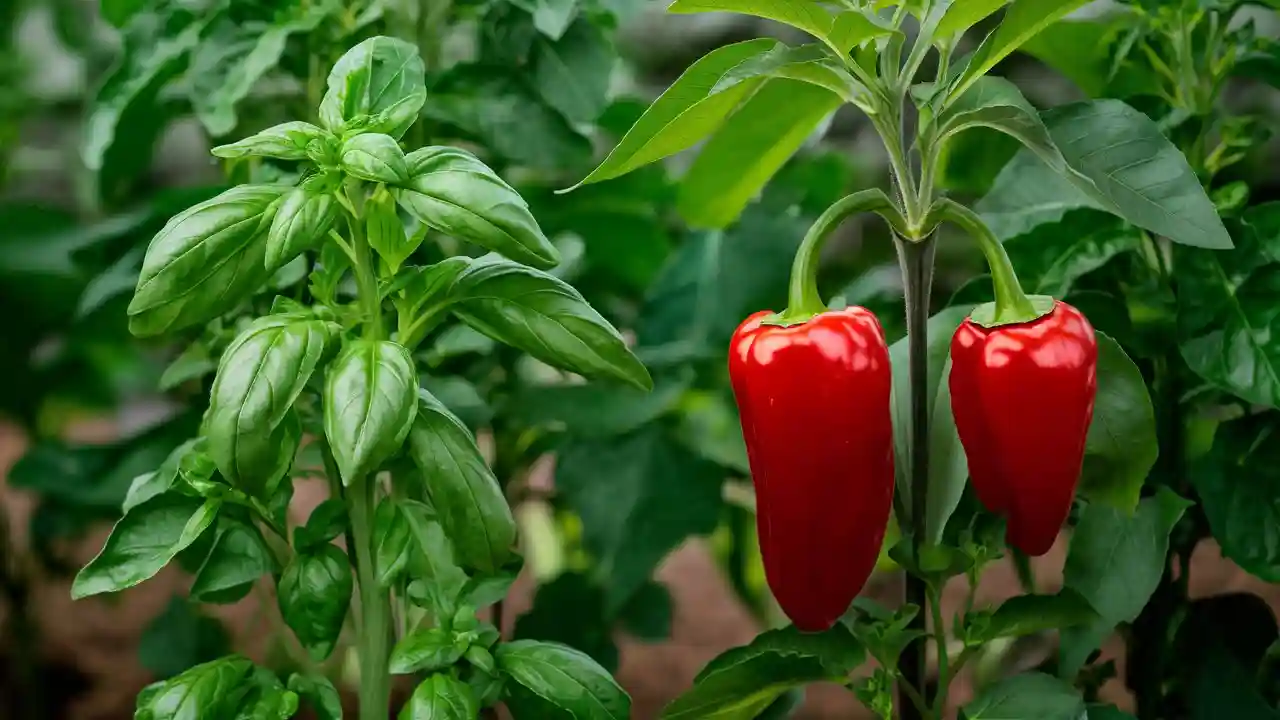
Benefits of Planting Basil with Peppers
Companion planting basil with peppers offers a myriad of advantages that can enhance the health and productivity of both plants:
- Improved Pest Repellence: Basil’s aromatic foliage releases volatile compounds that deter common pests such as aphids, whiteflies, and spider mites. These pests can wreak havoc on pepper plants, but basil’s presence helps create a protective barrier.
- Enhanced Growth and Yield: Studies have shown that basil can stimulate the growth and yield of pepper plants. Basil’s roots release substances that promote nutrient uptake and root development in peppers, resulting in healthier plants and increased fruit production.
- Improved Flavor: Some gardeners believe that planting basil alongside peppers enhances the flavor of the peppers. Basil’s aromatic oils may impart subtle notes of sweetness and complexity to the peppers, creating a more nuanced flavor profile.
- Efficient Space Utilization: Companion planting basil and peppers allows for efficient use of garden space. Basil can be planted between rows of peppers or around the perimeter of the pepper bed, maximizing the available growing area.
- Aesthetic Appeal: The vibrant green foliage of basil creates a visually appealing contrast with the glossy leaves and colorful fruits of peppers, enhancing the overall aesthetic appeal of the garden.
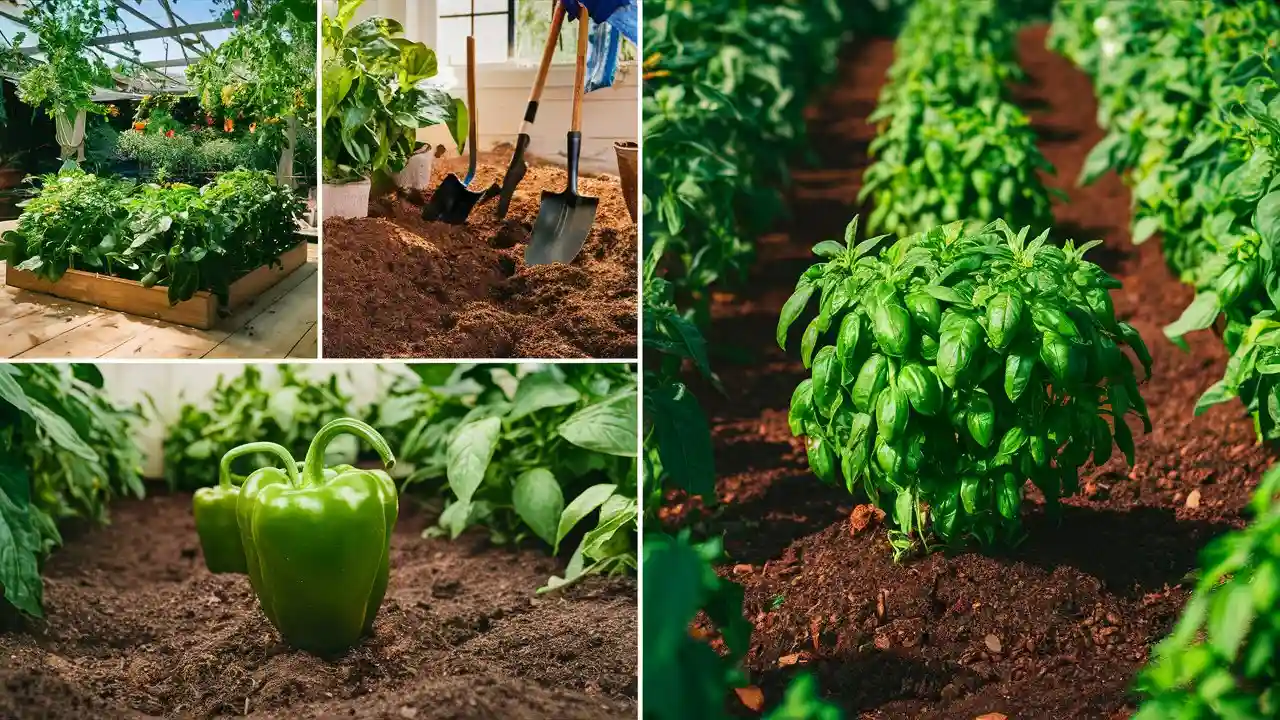
How to Plant Basil with Peppers
Planting basil and peppers together is a simple process that can be done in a few easy steps:
- Choose a planting site: Select a location in your garden that receives at least six hours of sunlight per day and has well-drained soil.
- Prepare the soil: Amend the soil with compost or manure to improve drainage and fertility.
- Plant the peppers: Dig holes that are twice the width of the pepper root balls and deep enough so that the top of the root ball is level with the soil surface. Space the pepper plants 18 to 24 inches apart.
- Plant the basil: Plant the basil seedlings around the pepper plants, spacing them 6 to 12 inches apart. Water the plants deeply after planting.
Once you have planted your basil and peppers, you can care for them as you would any other vegetable plant. Water them regularly, fertilize them every few weeks, and protect them from pests and diseases.
When to Plant Basil with Peppers
Timing is crucial when companion planting basil and peppers. Both plants thrive in warm temperatures, so it’s best to plant them after the last frost date in your area. In most regions, this falls between mid-spring to early summer.
To ensure optimal growth, start basil seeds indoors 6-8 weeks before the last frost date. Transplant the seedlings into the garden when they have developed their first set of true leaves. Peppers, on the other hand, are typically started indoors 8-10 weeks before the last frost date. Transplant pepper seedlings into the garden when they are 6-8 inches tall.
When planting basil with peppers, consider the size and growth habits of each plant. Basil can grow quite bushy, so it’s best to plant it on the north or east side of the peppers to avoid shading them. Additionally, basil is a relatively short-lived plant, so it can be interplanted with peppers that have a longer growing season.
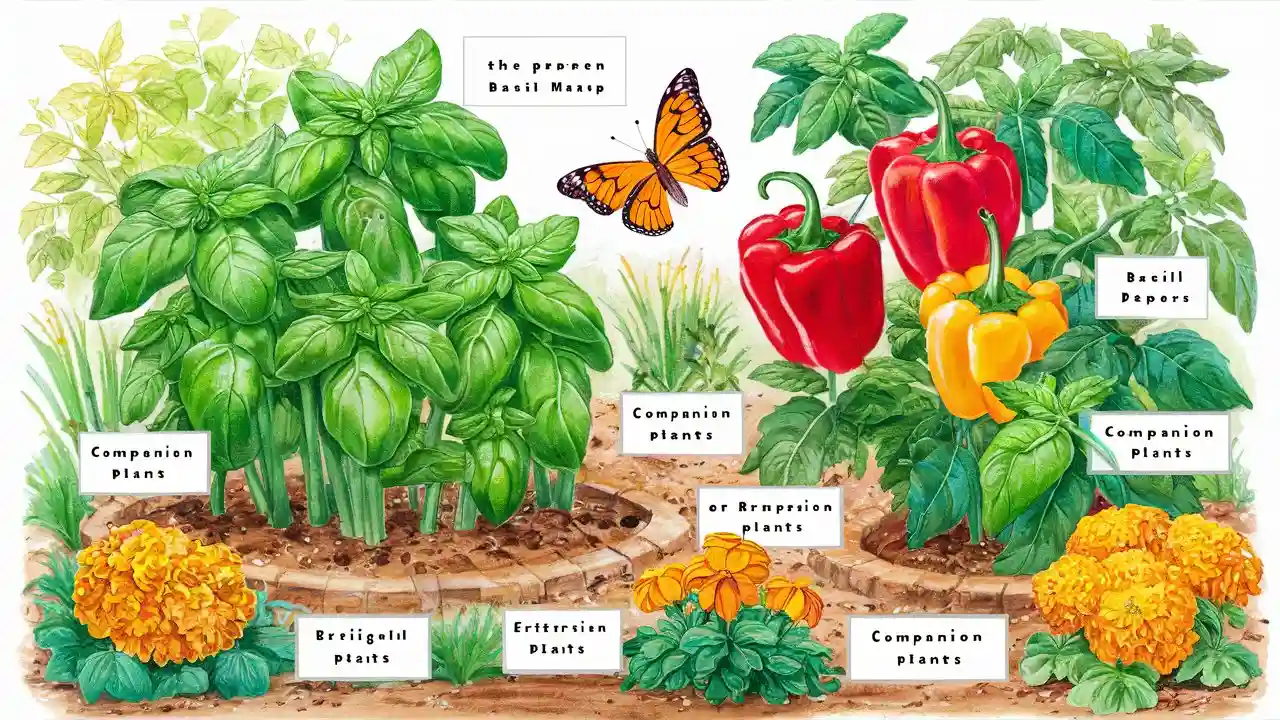
Where to Plant Basil with Peppers
When selecting a planting location for basil and peppers, consider the following factors:
- Sunlight: Both basil and peppers thrive in full sun, receiving at least six hours of direct sunlight per day.
- Soil: Well-drained soil rich in organic matter is ideal for both plants. Amend the soil with compost or manure to improve fertility and drainage.
- Spacing: Plant basil and peppers 12-18 inches apart to provide adequate space for growth and air circulation. Avoid overcrowding, as it can lead to disease and stunted growth.
- Companion planting: Consider companion planting basil with peppers to enhance growth and pest resistance. Plant basil around the perimeter of the pepper plants to deter insects and improve pollination.
- Crop rotation: To prevent soil-borne diseases, practice crop rotation by planting basil and peppers in different locations each year.
By carefully considering these factors, you can create an optimal growing environment for both basil and peppers, maximizing their growth and productivity.
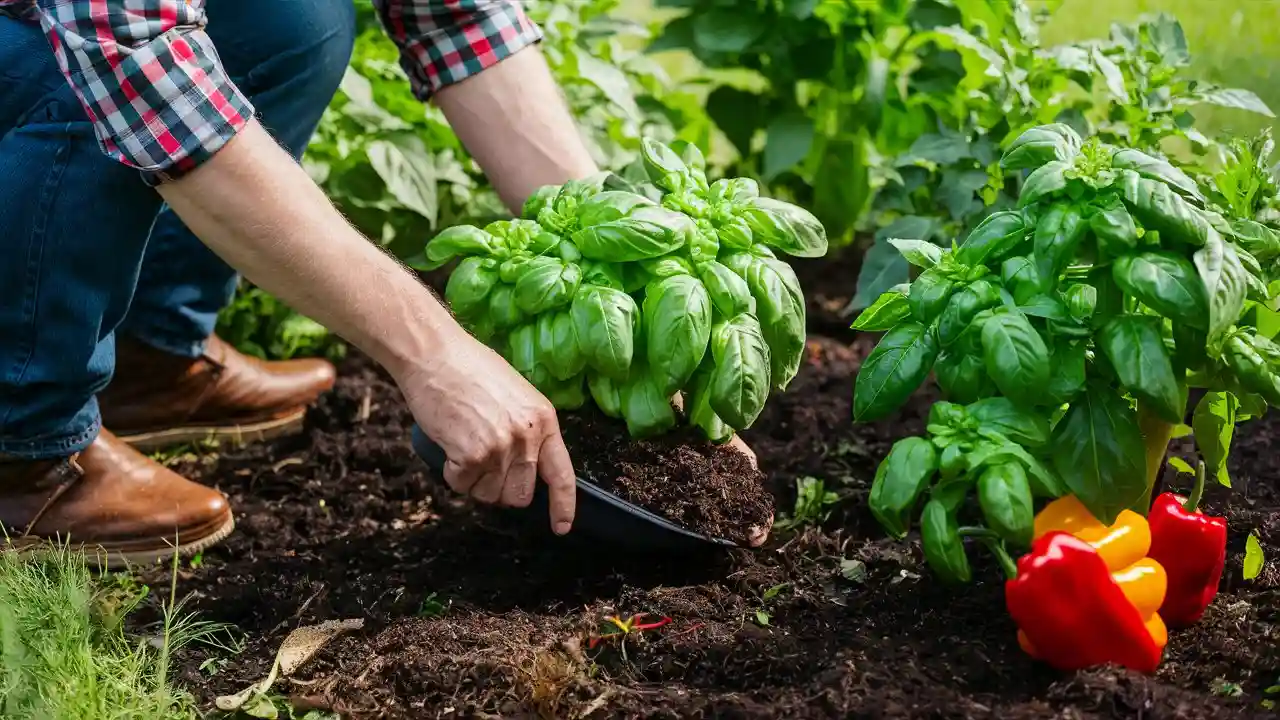
Soil Preparation for Basil and Peppers
Preparing the soil for basil and peppers is crucial for their optimal growth and productivity. Here are the steps to ensure proper soil preparation:
Soil pH: Both basil and peppers prefer well-drained soil with a pH between 6.0 and 6.8. If your soil is too acidic or alkaline, amend it with lime or sulfur to adjust the pH to the desired range.
Soil Drainage: Good drainage is essential to prevent root rot. Choose a planting site with well-drained soil or amend the soil with organic matter, such as compost or peat moss, to improve drainage.
Soil Fertility: Basil and peppers are moderate feeders, so they require fertile soil. Amend the soil with a balanced fertilizer or compost before planting. Avoid over-fertilizing, as this can lead to excessive vegetative growth and reduced fruit production.
Organic Matter: Adding organic matter, such as compost or manure, to the soil improves its structure, fertility, and water retention. Incorporate organic matter into the soil before planting to enhance its quality.
Raised Beds: If your soil is not well-drained or fertile, consider planting basil and peppers in raised beds. Raised beds provide better drainage, allow for easier soil amendment, and extend the growing season.
Watering and Fertilizing Basil and Peppers
Watering: Both basil and peppers prefer moist, well-drained soil. Water regularly, especially during hot, dry weather. Avoid overwatering, as this can lead to root rot. Mulching around the plants can help retain moisture and suppress weeds.
Fertilizing: Basil and peppers are moderate feeders. Fertilize them every few weeks with a balanced fertilizer. A fertilizer with a ratio of 10-10-10 is a good choice. Avoid over-fertilizing, as this can lead to leggy growth and reduce fruit production.
Additional Tips:
- Water basil and peppers at the base of the plant to avoid getting the leaves wet.
- Use a soaker hose or drip irrigation system to water deeply and evenly.
- Fertilize basil and peppers according to the manufacturer’s instructions.
- Avoid overwatering or over-fertilizing, as this can harm the plants.
Pest and Disease Control for Basil and Peppers
Maintaining a healthy garden environment is crucial for the success of companion planting basil and peppers. Pests and diseases can pose significant threats to these plants, potentially reducing yields and compromising their overall health. Implementing effective pest and disease control measures is essential to safeguard your garden and ensure a bountiful harvest.
Common Pests: Aphids, whiteflies, spider mites, and thrips are common pests that can infest basil and peppers. These insects feed on plant sap, causing damage to leaves and stems. Regular monitoring of your plants is key to early detection and prompt treatment.
Disease Prevention: Fungal diseases such as powdery mildew, blight, and root rot can affect basil and peppers. Proper watering practices, ensuring good drainage, and providing adequate air circulation can help prevent these diseases. Avoid overwatering, as it creates favorable conditions for fungal growth.
Organic Pest Control: Neem oil, insecticidal soap, and companion planting with beneficial insects like ladybugs and lacewings can effectively control pests without resorting to harsh chemicals. These natural methods are environmentally friendly and promote a balanced ecosystem in your garden.
Disease Management: If diseases occur, remove affected plant parts promptly to prevent further spread. Fungicides can be used in severe cases, but always follow the instructions carefully and consider organic options whenever possible.
By implementing these pest and disease control measures, you can protect your basil and pepper plants, ensuring a healthy and productive garden. Regular monitoring, early detection, and appropriate treatment are essential for maintaining a thriving companion planting system.
Harvesting Basil and Peppers
Harvesting basil and peppers is a rewarding experience that signals the culmination of your gardening efforts. Here’s how to ensure a successful harvest:
Basil:
- Harvest basil leaves regularly by pinching off the tips of the stems.
- This encourages bushier growth and prevents the plant from flowering, which can reduce leaf production.
- Basil can be harvested throughout the growing season, as long as it receives adequate sunlight and water.
Peppers:
- Harvest peppers when they reach their desired size and color.
- Cut the peppers from the plant with a sharp knife or scissors, leaving a small stem attached.
- Peppers can be harvested at various stages of ripeness, depending on your preference.
- Green peppers are harvested early and have a slightly bitter taste, while red, yellow, or orange peppers are fully ripe and sweeter.
By following these guidelines, you can enjoy a bountiful harvest of flavorful basil and peppers, maximizing the benefits of companion planting these two garden favorites.
Conclusion
Companion planting basil and peppers offer a multitude of benefits for home gardeners. By understanding the compatibility of these two species, you can maximize your garden space and reap the rewards of a bountiful harvest. Whether you’re a seasoned gardener or just starting your green thumb journey, the information provided in this guide will empower you to create a thriving garden ecosystem where basil and peppers flourish side by side.
Remember, the key to successful companion planting lies in proper planning and execution. By following the guidelines outlined above, you can create a harmonious garden environment where basil and peppers thrive, providing you with a steady supply of fresh, flavorful produce throughout the growing season.
Frequently Asked Questions
Can I plant basil with peppers?
Yes, basil and peppers are compatible companion plants. Basil helps to repel insects that can damage peppers, and it can also improve the flavor of the peppers.
How far apart should I plant basil and peppers?
When planting basil with peppers, space the plants about 12 inches apart. You can also plant basil in containers with peppers.
When should I plant basil with peppers?
The best time to plant basil with peppers is after the last frost date in your area. In most regions, this falls between mid-spring to early summer.
Where should I plant basil with peppers?
When selecting a planting location for basil and peppers, consider the following factors: sunlight, soil, spacing, companion planting, and crop rotation.
How do I care for basil and peppers?
Once you have planted your basil and peppers, you can care for them as you would any other vegetable plant. Water them regularly, fertilize them every few weeks, and protect them from pests and diseases.
